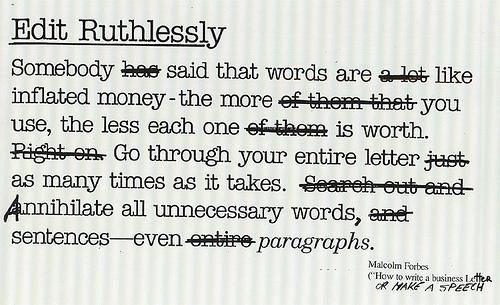You’ve slaved hard over a piece of writing and taken care to eliminate the jargon only to be told by the boss or a kindly critic that you’ve dumbed it down too much … and the writing needs to be more technical to show the world that you are the industry experts you claim to be.
My advice is to fight back and keep it simple. Jazzing up a piece of writing with long words might be the quickest way to lose your audience.

As a copywriter I often get asked to elaborate the copy or find a better word for [X] where [X] is probably the best word I could use because it’s precisely what the client does. A copywriter’s job isn’t to mindlessly embellish, it’s to show you the path of least resistance when communicating with your target audience. Copywriting is about writing fluently, precisely and concisely.
How do you practise the art of simplicity in your writing?
I thought I’d turn to the Plain English Campaign for their advice on the matter. The Plain English Campaign was established in 1979 and the term ‘plain English’ became more recognised in the early 1990s with their accreditation schemes. These days referring to plain English as a movement seems outdated but it’s generally understood that the principles of plain English are the global standard for all business writing.
What is plain English?
‘Plain English’ means writing something as simply and directly as possible, in language that all readers will understand. It isn’t about dumbing down, it’s about maximising the number of people who will read, absorb and act on your words.
When should you use plain English?
If you are writing for a business, charity or public sector organisation, then the obvious answer is ‘all the time’. If you are writing information materials, technical guides or any communications where it is important that the reader understands exactly what you’re asking them to do, then it’s vital you do keep it as simple as possible.
Here are eight tips from the Plain English Campaign, you can read these in more detail in their How to write plain English guide:
Stop! And think before you start writing. Note the points you want to make in a logical order.Ultimately, these are only guidelines. What matters is always to keep the reader in mind and keep it simple. It’s a topic I often come back to – less is more. Refine, review, rewrite. Strip out all that jargon. Be confident and clear that five words are better than ten.
In the (alleged) words of Albert Einstein
‘If you can’t explain it simply, you don’t understand it well enough’.
Sometimes the simplest thing is to get a copywriter to write for you. You can be too close to the subject and struggle to tell it simply. So you know who to call if you need a bit of simplicity in your life …


